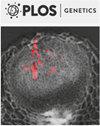Subfunctionalization of NRC3 altered the genetic structure of the Nicotiana NRC network
IF 3.7
2区 生物学
Q1 Agricultural and Biological Sciences
引用次数: 0
Abstract
Nucleotide-binding domain and leucine-rich repeat (NLR) proteins play crucial roles in immunity against pathogens in both animals and plants. In solanaceous plants, activation of several sensor NLRs triggers their helper NLRs, known as NLR-required for cell death (NRC), to form resistosome complexes to initiate immune responses. While the sensor NLRs and downstream NRC helpers display diverse genetic compatibility, molecular evolutionary events leading to the complex network architecture remained elusive. Here, we showed that solanaceous NRC3 variants underwent subfunctionalization after the divergence ofNRC3 的次功能化改变了烟草 NRC 网络的遗传结构
核苷酸结合域和富亮氨酸重复(NLR)蛋白在动物和植物对抗病原体的免疫中发挥着至关重要的作用。在茄科植物中,几种传感器 NLR 的激活会触发它们的辅助 NLR(即细胞死亡所需的 NLR(NRC)),形成抗原体复合物,启动免疫反应。虽然传感器 NLRs 和下游 NRC 辅助器显示出不同的遗传兼容性,但导致复杂网络结构的分子进化事件仍然难以捉摸。在这里,我们发现茄科植物的 NRC3 变体在茄科植物和烟草植物分化后经历了亚功能化,改变了烟草植物 NRC 网络的遗传结构。天然茄科植物 NRC3 变体形成了三个等位基因群,与传感器 NLR Rpi-blb2 具有不同的兼容性。通过对天然变体和嵌合变体的祖先序列重建和分析,确定了涉及传感器-助手兼容性的六个关键氨基酸。这些残基位于静止的 NRC3 同源二聚体的多个表面,共同促成了它们与 Rpi-blb2 的兼容性。激活后,与 Rpi-blb2 兼容的 NRC3 变体会形成与膜相关的点状高分子量复合物,并对晚疫病病原体 Phytophthora infestans 产生抗性。我们的研究结果揭示了 NRC 等位基因的突变是如何导致亚功能化、改变传感器-助手的兼容性并增加 NRC 网络的复杂性的。
本文章由计算机程序翻译,如有差异,请以英文原文为准。
求助全文
约1分钟内获得全文
求助全文
来源期刊

PLoS Genetics
生物-遗传学
CiteScore
8.10
自引率
2.20%
发文量
438
审稿时长
1 months
期刊介绍:
PLOS Genetics is run by an international Editorial Board, headed by the Editors-in-Chief, Greg Barsh (HudsonAlpha Institute of Biotechnology, and Stanford University School of Medicine) and Greg Copenhaver (The University of North Carolina at Chapel Hill).
Articles published in PLOS Genetics are archived in PubMed Central and cited in PubMed.
 求助内容:
求助内容: 应助结果提醒方式:
应助结果提醒方式:


